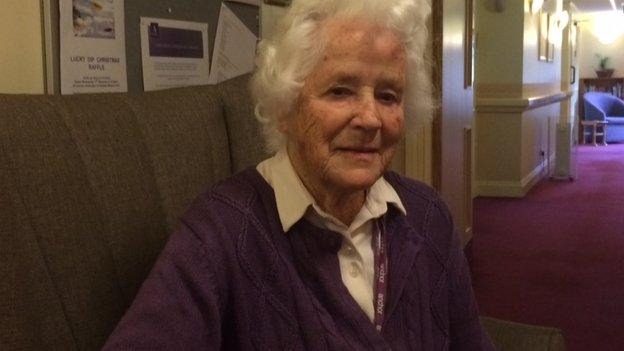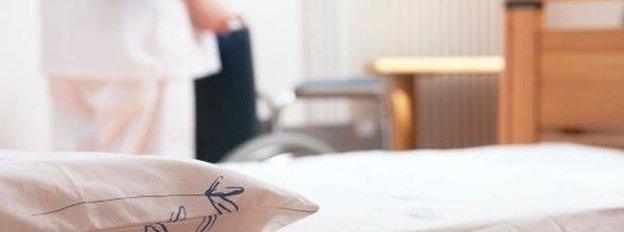A day in the life of a care home
- Published
Watch a day in the life of Eastlake care home in Surrey
At Eastlake Care Home staff make sure that all 52 residents have their clothes washed separately. It may seem a trivial thing, but to Linda Grout, the home's manager, it's important.
"It would be much easier to mix them all in together, but I think about what I would like if I was here. It is all about providing personalised care. This is their home after all."
Her care home - part of the not-for-profit Anchor group - is situated on the outskirts of the Surrey village of Godalming.
The day really begins at 07:30. That is when the care staff arrive and go through what needs to be done. The residents with hospital appointments or other engagements are prioritised.
The residents all have different levels of need. Some have late-stage dementia, some terminal cancer, while others have mobility issues or sight problems. Most are in their 80s and 90s, although the youngest resident is in her mid-60s.
The mornings are always busy, as many need help washing and dressing.
Breakfast is at 09:00 and served in each of the home's four dining areas.
Some residents sit together. Some sit alone. It all depends on their personal preference.
At some tables, the diners are in deep conversation - just like you would expect in any cafe or restaurant.
But at others there is silence, reflecting the fact that one of the consequences of the ageing population is the degeneration in brain function, leaving people confused and with limited ability to communicate. I hear one resident, when it is explained why the BBC is at the home, ask her fellow resident: "Are we in a care home?"

BBC Cost of Care project

The BBC has launched an online guide to the care system for the over-65s. The "care calculator" covers both residential care and the support provided in people's own homes, for tasks such as washing and dressing.
Users can submit their postcode and find out how much each service costs wherever they live in the UK.
There is also a dedicated BBC Cost of Care website with news stories, explainers, analysis and video.

One of the most popular activities in the home - and one which evidence suggests is good for the brain - is singing. After breakfast, the staff - one of whom plays the piano - lead the residents in a round of old-time classics.
Well over half the residents attend. One is Fay Dadley, 91, who moved into the home a year ago. "I love the singing," she says. "My favourites are the ones from the shows. But we do a whole variety."
She has mobility issues after a succession of hip replacements and bowel cancer and knew of the home because her late husband had spent two years there before he died.

Eastlake care home is one of the better ones in the country, according to regulators

Jessamine Betteridge sold her home to pay for care
She speaks highly of the home, citing the day trips, quality of the food and friendly staff. "Whatever you want, they will do for you," she says. "Even if you want something in the middle of the night."
Each resident has a pendant with an alarm and there is one attached to their bed, so they can call for help wherever they are in the home.
"It's a reassurance, but I never use mine," says Mrs Dadley. "I read a lot in my room, but there is always someone nearby, checking you are all right."
Of course, such living arrangements - in many ways the care home resembles a modest hotel with the set dining times, communal lounges, en-suite rooms and (almost) identical furniture - can take some getting used to.
One resident tells me she dislikes the rules and structure. "They are always telling me what to do," she says.

Is Eastlake typical?

More than 400,000 people live in care homes in the UK. Eastlake is undoubtedly among the better care homes.
According to the Care Quality Commission, it meets all five essential standards. Such compliance, while not rare, is not seen everywhere.
The latest CQC annual report notes that there is "significant variation" in the care home sector, with nursing homes tending to fare worse than residential care homes. Compliance with standards hovers around the 90% mark.

But, equally, others find it a comfort. Widow Joan Weston 91, moved into the home six months ago. She had been on the waiting list for several years, but had turned down two offers of a place, to stay in her own home.
"In the end I think it got too much for me," she says. "I was lonely and was struggling at home. Here, there are always people to talk to and things to do."
But like many people who move into residential care, it has come at a cost. She owns her own home - a flat in a nearby village - and has a modest amount of savings. It means she has to pay the full cost of her care herself.
Eastlake charges those who pay for themselves - known as self-funders - just over £1,000 a week. By comparison the local council - Surrey - has negotiated a rate of £539 for the residents it places at the home.
Mrs Weston says: "It is a lot of money and I do worry about how quickly my money will run down, but I felt it was the best option for me."

Why do the costs vary?

It is commonplace for people who pay the full cost of their care to pay much more than those who are placed in care homes by their local authority. Research group Laing and Buisson shows fees can differ by hundreds of pounds a week.
The prices of Eastlake are proof of this. The self-funders pay over £1,000 a week, whereas the council has negotiated a rate of £539 - although it pays that whether the room is occupied or empty.
"It is a tricky one," says the home's manager, Linda Grout. "I would say the council does not pay enough. I have over 80 staff. If you pay peanuts, you get monkeys. Without self-funders, we would not be viable."

Others are less concerned. Jessamine Betteridge, another widow, who is 94 and registered blind, says: "I sold my home, and my son has invested it. He tells me I've got enough to live off until I'm 120 so I think I will be OK. It doesn't bother me really. It's my money so why shouldn't I use it for my care."
After talking to the BBC, Ms Betteridge goes off to do some cake decorating with help from the staff at the home.
The decorating is done in one of the dining rooms after lunch has been served. The residents are offered a choice of what they want. On the day the BBC visited, the two main hot options were salmon and mince-beef pie followed by apple sponge and custard. Staff also use lunch to give residents any medication they need.
The cake decorating is just one of a number of activities arranged by the staff - quizzes, scrabble games, knitting and - when the weather is nice - gardening. Trips out to day centres, the coast and local schools to see their plays are also arranged.
The evenings tend to be a lot quieter. The residents relax, watch some television or talk. Staff spend time with them just chatting.
Doug Rollings, 89, is one of those who likes to sit back and take it all in. He struggles to communicate, but has clearly not lost his sense of humour.
When a member of staff tells him the BBC wants to talk to him about how well cared for he is, he quips: "I'll tell them how bad it is."